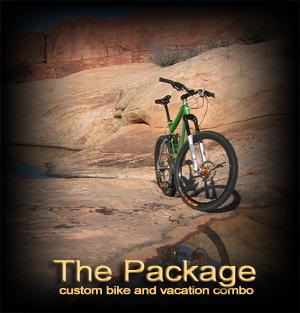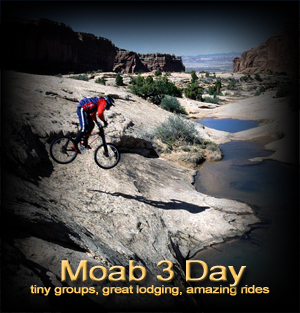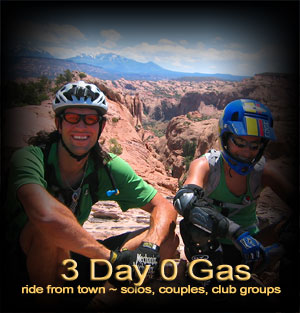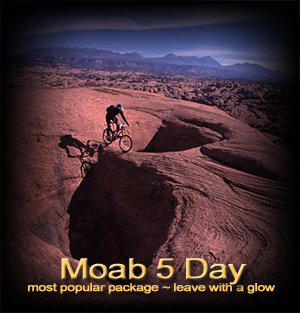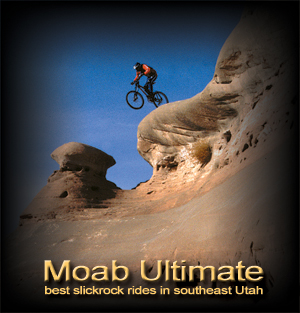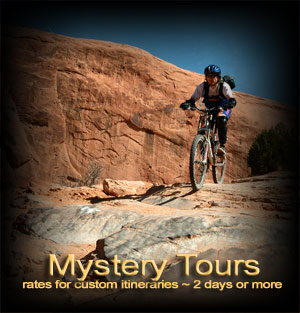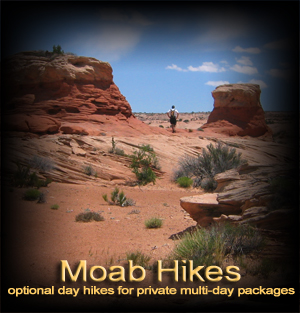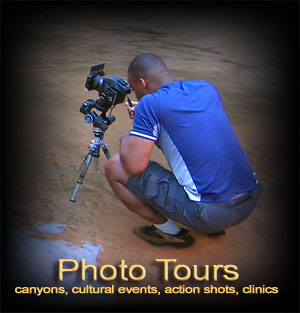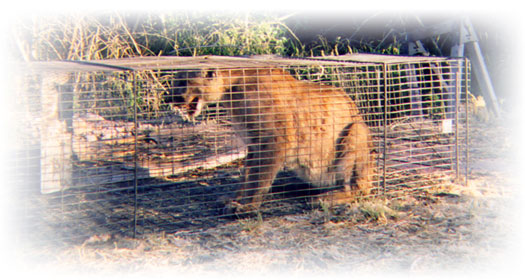
Mountain Lions in the Moab Valley Wetlands
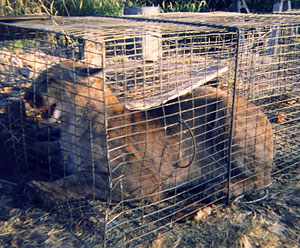 When white people came to America and first saw the mane-less American cougar, they asked the locals why they saw only female lions. The Indians told them, tongue in check, that the males all lived in the mountains. Hence, the name, mountain lion.
When white people came to America and first saw the mane-less American cougar, they asked the locals why they saw only female lions. The Indians told them, tongue in check, that the males all lived in the mountains. Hence, the name, mountain lion.
This mountain lion, or cougar, if you prefer, was trapped in the backyard of Dreamride's Moab shop next to Bullock Creek Wetland Park in 1999. He was just over a year old, large and well nourished. Before Moab Animal Control arrived on the scene he had chewed away a corner of the metal cage. He was tranquilized and released into Gold Basin. Mountain lions are routinely hunted in Gold Basin. A young male mountain lion was reportedly killed there a couple of months after the release and many conclude that it was this lion. We hope not.
~ Lee Bridgers, Dreamride owner
P.S. The following is an article from the Moab Times Independent newspaper published January 21, 2005:
Two cougars were spotted about 200 yards from a Riversands Drive home last Friday morning in the most recent of about half a dozen big cat reports since November.
In 2004 15 sheep on a nearby property were taken by a mountain lion, or perhaps a breeding pair. After loosing a dozen sheep one or two at a time over the year our neighbor grabbed his gun and slept with the remaining three sheep in hopes of killing or scaring the lion(s) away. After a single night he awoke on the ground to find lion tracks all around him, . . . and no more sheep.
There is a confluence of two creeks behind us. This is beaver territory, though the beavers are having problems with people who don't like beavers. Beavers are "protected," but they chomp trees down and flood places. The also create standing water and dissipate the effects of flash floods. Which brings us to mosquitos. Moapa, the original Ute name for the Moab, means "mosquito." The mosquitos in Bullock Park bring Mosquito Abatement. A few months ago a Mosquito Abatement guy working behind the shop came upon a mountain lion walking toward him on the trail. They both turned around and went the other way. The Abatement guy quit Abating. The mountain lion is still a mountain lion.
When we first moved into this location there were two house cats roaming regularly. When the weather turned cold in early December both cats vanished. I have a sneaky suspicion our cougar survived his vacation in the mountains and is back in the valley with a healthy respect for metal cages. Maybe his parents are the ones who are eating the pets and sheep, but it is certain that the Moab Valley's wetlands are a great place for predators. Several species of cat seem to dominate, but we also see many raptors. Coyotes are rare and I have never heard of a bear in town.
Deer wander around the yard at 6AM in spring and sleep in several spots on the property most of the year. Hundreds, maybe thousands, of snakes hybernate underground to emerge every spring from a hole on our property, causing a stir among the kids in the neighborhood. Desert ringtail cats hop through the trees. Squirrels burrow holes in the yard. Skunks and badgers do what you let them do to your house. Now, I know that mothballs turn away skunks and urine discourages badgers. Our favorite vistors, the corvids--magpies, ravens, and crows, are more than welcome. I erected a small corvid feeding station on the spot where the lion was trapped. Magpies, ravens, falcons and kestrels have fed on our scaps, chicken liver and buffalo jerky offerings. The weird fence next to the shop is a feeding station. In the mornings from inside the shop we watch ravens munch away on nuts, bread and potato chips.
The former owner of this property, Mr. Gay, the fellow who trapped the mountain lion, also trapped hundreds of skunks. Animal Control kills the skunks. They have a rationale that is logical and sound, but trapping should be avoided, a last, last resort. When I tried to trap a badger which Animal Control told me was a skunk, I got a cat instead. The badger just backed out of the small trap with his peanut butter and tuna reward and a new knowledge of traps. I don't think he will walk into one again. A domestic cat in a trap is agitated and afraid, but the stress of containment and manipulation is life threatening to a wild animal. The mountain lion broke teeth and ripped his lips and gums in the attempt to break out of the cage. The badger was successfully evicted by peeing, constructing a cement barrier where it had dug under the foundation and by the fact that he probably ate all the snakes under the house and there was no more reason to dig. Speaking of digging, have you ever seen a badger's front claws? They are massive blades like a rigid garden rake, only larger. This badger now roams the back of the property in the evening. It seems that I am just beginning to set boundaries and establish my territory. I do not want to upset the natural order while we run a business next to the "Moab Zoo."
DWR: Mountain lions probably pose no threat; public urged, however to contact authorities with detailed reports of predator activities
by Carrie Switzer
staff writer
"They are not causing any problems," said Division of Wildlife Resources investigator Sergeant Ed Meyers said. (sic) "They are just wandering through, several hundred yards away from residences.
Andy and Wendy Pitas said they had a clear view of two young-looking cougars at about 8 a.m. on Friday. Neighbor James Maddoz reported hearing his dogs barking and coyotes howling during the night. Yet another neighbor, who didn't leave his name on the DWR answering machine, was the one to call in the report. That person had also seen a mountain lion.
The Pitases said the usual head of nine deer in their neighborhood was double that morning, with about 18 deer looking anxious.
"That usually means there's a very large predator in the area," Andy Pitas said. "The cougars were in plain sight for 10 minutes."
The Riversands report is the latest in a number of reports - both confirmed and unconfirmed - of cougar sightings, tracks, or evidence of feeding, such as a torn deer carcass. In November a pheasant hunter reported seeing a deer, torn up, apparently by a large animal, in the Matheson Wetlands. Meyers said the division was unable to confirm that sighting because the call was anonymous and no decription of the area was left for investigating officers.
Also in November the division received a report of cougar tracks in the wetlands. Meyers said that report was investigated and no tracks were found.
"It has been our experience with bear and cougar that rumors of sightings lead to numerous reports, many of which cannot be identified," Meyers said.
Two more sightings have also been reported over the last six weeks, Meyers said: one out past Allen Memorial Hospital and another in the same area in which a woman spotted a cougar in her headlights.
Joe Nicholson, also an investigator with the division, said sporatic reports of wildlife such as bear and cougar are common in rural areas because animals of prey will move closer to populated areas when the deer move. He said the nature of the cougar as a "secretive animal,' makes it very difficult to track. In addition to the wetlands, Nicholson said there were a few sightings in Spanish Valley last year.
"Two years ago we had several reports of cougar in Castle Valley," Nicholson said. "There are two ways we can deal with it - with a trap or with hounds and a tranquilizer gun. Neither one works very well in town."
But, Nicholson adds, if an accurate report is made swiftly to the sheriff's office or the Division of Wildlife Resources, a cougar may be tracked as it returns to its feeding ground for several consecutive days.
"An adult will kill one deer a week," Nicholson said. "If we can find a freshly-killed animal, we can set a snare. We used that method several years ago and got three cougar in a period of two days."
Meyers said that the division would respond as quickly as possible to verify any sightings and evaluate a response.
"We would like to relocate any cougars which appear to be living near town," he said. "Cougars which pose a threat to human safety or domestic livestock will be euthanized."

FAX number is 435-259-8196.
or write to:
DreamrideP.O. Box 1137
Moab, UT 84532
For email contact information click on:
CURRENT DREAMRIDE EMAIL ADDRESS
copyright Dreamride 1997-2005 None of the material, written, graphics, or photographs, may be broadcast, published, re-written, re-edited, or used in any way outside of this site without the written consent of Dreamride Mountain Bike Tours and Film Services and Lee Bridgers. Use of this site signifies agreement to terms of use.
